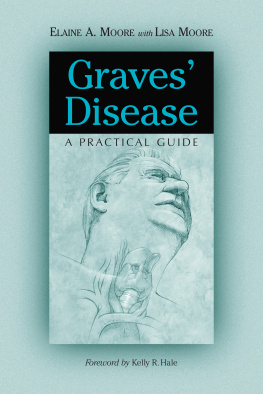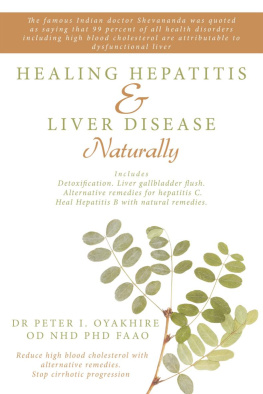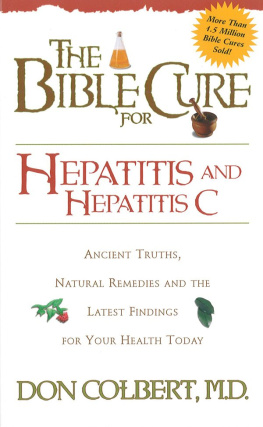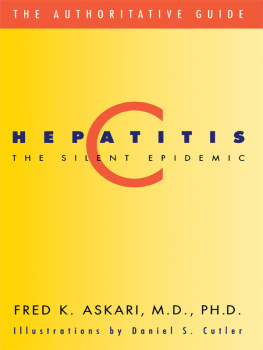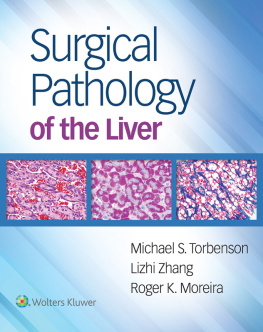
Table of Contents
ALSO BY ELAINE A. MOORE AND WITH MCFARLAND
Autoimmune Diseases and Their Environmental Triggers (2002)
WITH LISA MOORE
Encyclopedia of Sexually Transmitted Diseases (2005)
Encyclopedia of Alzheimers Disease; With Directories of Research, Treatment and Care Facilities (2003)
Graves Disease: A Practical Guide (2001)
LIBRARY OF CONGRESS CATALOGUING-IN-PUBLICATION DATA
Moore, Elaine A., 1948
Hepatitis : causes, treatments and resources / Elaine A. Moore.
p. cm.
Includes bibliographical references and index.
ISBN-13: 978-0-7864-2623-2
1. HepatitisPopular works.
I. Title.
RC848.H42M66 2006
616.3'623dc22 2006020688
British Library cataloguing data are available
2006 Elaine A. Moore. All rights reserved
No part of this book may be reproduced or transmitted in any form or by any means, electronic or mechanical, including photocopying or recording, or by any information storage and retrieval system, without permission in writing from the publisher.
Cover photograph 2006 Comstock.
McFarland & Company, Inc., Publishers
Box 611, Jefferson, North Carolina 28640
www.mcfarlandpub.com
Preface
Developing hepatitis can be compared to being struck by a stray ball. For some people, the ball merely grazes the skin and is soon forgotten. For a smaller number of individuals, this acute assault, like acute hepatitis, can have serious ramifications, including death. For most people, symptoms are mild and resolve within a few weeks to a few months. If the ball caused irreparable internal damage or if hepatitis progressed into a chronic condition, tissue damage could persist indefinitely although complications might not be noticed for many years. Whether the hepatitis is acute or chronic, preventive measures are available, injuries may cause no symptoms; treatment options offer benefits; and individual occurrences are unique events capable of permanently resolving or causing a legacy of lingering effects.
Hepatitis, a disease characterized by liver inflammation or injury, is an ancient disorder with both infectious and non-infectious origins. Virtually any assault to the liver can damage the livers cells and elicit an immune response resulting in inflammation.
The word hepatitis stems from hepato, derived from the Greek word hepatikos, which refers to the liver, and -itis, a suffix meaning the fire within, which is used to describe inflammation. The word hepatitis was first coined in 1912 to describe the epidemic viral form of the disease.
However, hepatitis doesnt refer to viral hepatitis alone. Hepatitis is a collective term referring to a broad class of diseases causing liver injury or inflammation. Hepatitis can also be caused by bacteria and toxins, and it can result from metabolic disorders, including obesity and the iron overload disorder hemochromatosis.
The first records of epidemic hepatitis, presumably caused by the hepatitis A virus (HAV), date back to Hippocrates, in his description of an epidemic of jaundice on the Greek island of Thassos in 510 B.C. Since that time there have been numerous hepatitis epidemics reported worldwide, especially during wars, with 10-year cycles of increased prevalence.
Before 1948, all infectious hepatitis was presumed to be caused by one virus referred to as hepatitis A. HAV had, by then, been found in the feces of infected patients and was known to be spread by contaminated food and water. Serum hepatitis had also been identified by 1948, but no one had yet discovered its viral origin.
By 1961, however, scientists realized that other viruses, toxins, parasites and bacteria could all cause hepatitis with most infectious hepatitis presumably caused by HAV. The 1962 Merck Manual refers to serum hepatitis as inoculation hepatitis, transfusion hepatitis, viral hepatitis and hepatitis B as a means of distinguishing it from hepatitis caused by HAV [43].
Soon after the discovery of hepatitis B virus (HBV) in 1966, blood tests for it were developed. People with symptoms of infectious hepatitis with negative tests for HAV and HBV were said to have non-A, non-B (NANB) hepatitis. In 1988 the hepatitis C virus was isolated and found to be the primary cause of NANB hepatitis. The discoveries of the hepatitis D, E, F and G viruses soon followed.
In the United States the hepatitis viruses AD are responsible for most cases of viral hepatitis. However, other viruses, such as cytomegalovirus (CMV), Epstein-Barr virus, varicella and herpes viruses, described in chapter four, can also be responsible.
Hepatitis causes an acute disease that may persist, causing chronic disease. Chronic hepatitis is responsible for the true disease burden of hepatitis. Approximately 1.25 million Americans are chronically infected with HBV, and an estimated 2.7 million Americans are chronically infected with HCV [17]. Blood products used before 1990 account for most of the chronic hepatitis in the U.S. The introduction of blood tests for HBV and HCV has dramatically reduced hepatitis transmission. Today, 61 percent of new HCV cases are caused by intravenous drug use.
The hepatitis A virus (HAV), which causes acute but not chronic illness, affects about 25 percent of the population worldwide, usually children, in whom it seldom causes symptoms. In some undeveloped countries, HAV is endemic. Although the course of HAV tends to be milder than that of HBV and HCV, in the United States HAV causes approximately 100 fatalities related to acute liver failure annually [17].
Besides transmission through blood products, hepatitis viruses can be transmitted via intravenous drug use, hemodialysis, childbirth, organ transplants, contaminated food, unsanitary conditions, occupational exposures, and sexual intercourse. Patients with the clotting factor deficiencies hemophilia and thallasemia, an inherited form of anemia, have the highest risk because they typically receive multiple transfusions or blood products made from hundreds of different donors.
Hepatitis caused by drugs results from more than 1,000 different medications. Alcohol abuse, toxic chemicals, bacteria and parasites can also be responsible. Hepatitis also occurs in several metabolic disorders, including shock (ischemic hepatitis or shock liver); Wilsons disease, a copper storage disease; hemochromatosis, an iron overload disorder; and alpha anti-trypsin deficiency. Hepatitis can also occur as an autoimmune liver disorder known as chronic autoimmune hepatitis.
The first three chapters of Hepatitis: Causes, Treatments and Resources focus on the history, symptoms, causes and disease course of the various hepatitis disorders. Normal liver function, the immune system response, and the changes in liver function caused by hepatitis and the effects of these changes on general health are also described. Risk factors and special concerns for the prison population, hemodialysis patients, children, and pregnant women are included.
Chapters 4 through 9 describe the infectious causes of hepatitis including hepatitis viruses, bacteria, parasites, cytomegalovirus, herpes viruses, varicella, and Epstein-Barr virus. For each microorganism, the epidemiology, symptoms, diagnosis, and disease course are included.
The non-infectious causes of hepatitis are described in chapters 10 through 12. Chapter 10 describes autoimmune hepatitis, and chapter 11 describes hepatitis caused by drugs, alcohol, and toxins. Chapter 12 describes hepatitis in metabolic disorders, such as Wilsons disease, non-alcoholic fatty liver, alpha 1-antitrypsin deficiency, galactosemia, tyrosinemia, and hemochromatosis.
Next page


